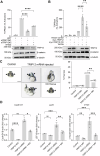The TRIP12 E3 ligase induces SWI/SNF component BRG1-β-catenin interaction to promote Wnt signaling
- PMID: 40473626
- PMCID: PMC12141612
- DOI: 10.1038/s41467-025-60535-5
The TRIP12 E3 ligase induces SWI/SNF component BRG1-β-catenin interaction to promote Wnt signaling
Abstract
SWItch/Sucrose Non-Fermentable (SWI/SNF) chromatin remodeling complexes displace nucleosomes to promote the access of transcription factors to enhancers and promoters. Despite the critical roles of SWI/SNF in animal development and tumorigenesis, how signaling pathways recruit SWI/SNF complexes to their target genes is unclear. Here, we demonstrate that target gene activation mediated by β-catenin, the essential transcriptional coactivator in the Wnt signal transduction pathway, requires ubiquitylation of the SWI/SNF component Brahma-related gene-1 (BRG1) by the E3 ubiquitin ligase Thyroid Hormone Receptor Interactor 12 (TRIP12). TRIP12 depletion in Drosophila, zebrafish, mouse organoids, and human cells attenuates Wnt signaling. Genetic epistasis experiments place TRIP12 activity downstream of the β-catenin destruction complex. TRIP12 interacts with and ubiquitylates BRG1, and BRG1 depletion blocks TRIP12-mediated Wnt pathway activation. TRIP12 promotes BRG1 binding to β-catenin in the presence of Wnt. Our findings support a model in which TRIP12 ubiquitylates BRG1 in the presence of Wnt and promotes its interaction with β-catenin in the nucleus, in order to recruit SWI/SNF to Wnt target genes. Our studies suggest a general mechanism by which cell signaling induces the interaction between BRG1 and pathway-specific transcription factors to recruit SWI/SNF complexes to their appropriate target genes.
© 2025. The Author(s).
Conflict of interest statement
Competing interests: E.L. and D.J.R. are co-founders of StemSynergy Therapeutics, a company that seeks to develop inhibitors of major signaling pathways (including the Wnt pathway) for the treatment of cancer. The remaining authors declare that they have no competing interests.
Figures








References
-
- Horn, P. J. & Peterson, C. L. Heterochromatin assembly: a new twist on an old model. Chromosome Res.14, 83–94 (2006). - PubMed
-
- Peterson, C. L. & Herskowitz, I. Characterization of the yeast SWI1, SWI2, and SWI3 genes, which encode a global activator of transcription. Cell68, 573–583 (1992). - PubMed
-
- Kwon, H., Imbalzano, A. N., Khavari, P. A., Kingston, R. E. & Green, M. R. Nucleosome disruption and enhancement of activator binding by a human SW1/SNF complex. Nature370, 477–481 (1994). - PubMed
-
- Rim, E. Y., Clevers, H. & Nusse, R. The Wnt pathway: from signaling mechanisms to synthetic modulators. Annu. Rev. Biochem.91, 571–598 (2022). - PubMed
MeSH terms
Substances
Grants and funding
- P20 GM113132/GM/NIGMS NIH HHS/United States
- R01CA244188/U.S. Department of Health & Human Services | NIH | Center for Scientific Review (NIH Center for Scientific Review)
- R35 GM118082/GM/NIGMS NIH HHS/United States
- K08 CA240901/CA/NCI NIH HHS/United States
- U41 HG000739/HG/NHGRI NIH HHS/United States
- P40 OD018537/OD/NIH HHS/United States
- F30 CA281125/CA/NCI NIH HHS/United States
- R01 GM118557/GM/NIGMS NIH HHS/United States
- R35 GM119455/GM/NIGMS NIH HHS/United States
- S10 OD032310/OD/NIH HHS/United States
- R01 CA244188/CA/NCI NIH HHS/United States
- P40 OD010949/OD/NIH HHS/United States
- R21 HD101980/HD/NICHD NIH HHS/United States
- P30 CA023108/CA/NCI NIH HHS/United States
- R35 GM122516/GM/NIGMS NIH HHS/United States
- R01 CA219189/CA/NCI NIH HHS/United States
- T32 GM007347/GM/NIGMS NIH HHS/United States
- T32 GM008554/GM/NIGMS NIH HHS/United States
- R35 GM136233/GM/NIGMS NIH HHS/United States
- P50 CA236733/CA/NCI NIH HHS/United States
- R01 CA272875/CA/NCI NIH HHS/United States
LinkOut - more resources
Full Text Sources
Molecular Biology Databases
Research Materials
Miscellaneous

